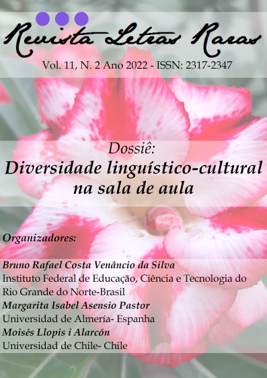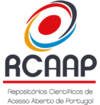The World English(es) and linguistic diversity in the English language class: proposal of a didactic activity
DOI:
https://doi.org/10.5281/zenodo.8215454Palavras-chave:
World English(es), Linguistic diversity, English language teaching, Didactic activityResumo
Due to the process of colonization of the British Empire and the current economic and cultural impact of the United States, it is not difficult to find discourses that associate the English language exclusively with these people. However, with globalization and technological advances, authors such as Crystal (2003) argue that the English language is currently a global language, since it has a prominent role around the world, including in the educational environment. Nonetheless, such a reach of the English language does not make it, in fact, conceived as a language of all, which may even influence the learning of English as an additional language. In such manner, we find the World English(es) (BOLTON, 2006; RAJAGOPALAN, 2005), perspective that promotes a plural conception of the English language, providing a vision of this language according to a perspective of multiplicity. Thus, the aim of this article is to discuss how the World English(es) can be a tool in the dissemination of linguistic diversity in the English class. In addition, a didactic activity of English teaching will be presented, formulated through the content-based approach (LEFFA, 2016), based on the prism of the World English(es) and linguistic plurality.
Downloads
Referências
ACCENT. In: Cambridge online dictionary. Cambridge University Press, 2021. Disponível em: <https://dictionary.cambridge.org/pt/dicionario/ingles/accent>. Acesso em 10 jun. 2021.
BAUER, L. An introduction to international varieties of English. Edinburgh: Edinburgh University Press, 2002.
BOLTON, K. World Englishes today. In: KACHRU, B. B.; KACHRU, Y.; NELSON, C. L. The handbook of World Englishes. Malden: Blackwell Publishing, 2006.
BOURDIEU, P. Sociologia. São Paulo: Ática, 1983.
BROWN, H.; BRADFORD, A. EMI, CLIL, & CBI: Differing approaches and goals. In: Transformation in language education. Tokyo: JALT, 2017.
CANI, J B., SANTIAGO, M. E. V. O papel do quadro comum europeu de referência para idiomas: aprendizagem, ensino e avaliação (QCER) na internacionalização das IES: uma análise sob a perspectiva do letramento crítico e dos multiletramentos. Trabalhos de Linguística Aplicada, Campinas, n. 57, 2018.
CONSELHO DA EUROPA. Quadro comum europeu de referência para as línguas: aprendizagem, ensino, avaliação. Edição portuguesa. Porto: Edições Asa, 2001. Disponível em:
http://area.dge.mec.pt/gramatica/Quadro_Europeu_total.pdf. Acesso em: 10 jul. 2021.
COSTA LEITE, P. C.; OLIVEIRA, A. C. T.; COURA, F. A. Inglês como língua franca, o mito da natividade e as implicações pedagógicas para o ensino/aprendizagem da língua inglesa. Trem de Letras, v. 7, n. 1, 2020.
CRYSTAL, D. English as a global language. Edinburgh: Cambridge University Press, 2003.
DIAGRAMA MOSTRA AS LÍNGUAS MAIS FALADAS DO MUNDO. Ipol, 2020. Disponível em:. Acesso em 15 de jun. 2021.
LEFFA, V. J. Língua estrangeira: ensino e aprendizagem. Pelotas: Editora da Universidade Católica de Pelotas, 2016.
MEHISTO, T. et al. Uncovering CLIL: Content and Language Integrated Learning in bilingual and multilingual education. Oxford: Macmillan Education, 2008.
NUNES, E. C. R.; CELIN, F. L. O problema da adequação dos parâmetros do quadro europeu comum de referência e “a necessidade de emergir como os outros de nós mesmos”. Revista X, vol. 2, 2011.
PASSETTI, G. Os britânicos e seu império: debates e novos campos da historiografia do período vitoriano. História, v. 35, 2016.
PENNYCOOK, A. Critical Applied Linguistics: A critical introduction. Londres: Lawrence Erlbaum Associates Publishers, 2001.
RAJAGOPALAN, K. A geopolítica da língua inglesa e seus reflexos no Brasil. In: LACOSTE, Y.; RAJAGOPALAN, K. (orgs.). A geopolítica do inglês. São Paulo: Parábola Editorial, 2005 (p. 135-159).
SCHNEIDER, E. W. English around the world: an introduction. Nova Iorque: Cambridge University Press, 2011.
SILVA, S. B. Da técnica à crítica: os letramentos críticos na formação de professores de inglês. Porto Alegre: Brejo, 2012.
SILVEIRA, A. C. A legitimação do constructo do falante nativo no processo de comoditização da língua inglesa. Philologus, ano 26, n. 78, 2020.
SPEAKING NEW ZEALAND ENGLISH. Naumai NZ, 2021. Disponível em: <https://naumainz.studyinnewzealand.govt.nz/help-and-advice/life-and-culture/speaking-new-zealand-english/>. Acesso em 25 maio 2021.
VILLALOBOS, O. B. Content-based instruction: A relevant approach of language teaching. Innovaciones Educativas. V. 15, n. 20, 2013.
WHAT IS COCKNEY RHYMING SLANG?. Cockney Rhyming Slang, 2021. Disponível em: <https://www.cockneyrhymingslang.co.uk/blog/what-is-cockney-rhyming-slang/>. Acesso em 12 de jul. 2021.
YIN, R. Qualitative Research from start to finish. Nova Iorque: The Guilford Press, 2011.
Downloads
Publicado
Como Citar
Edição
Seção
Licença
Copyright (c) 2023 Revista Letras Raras

Este trabalho está licenciado sob uma licença Creative Commons Attribution-NonCommercial 4.0 International License.







